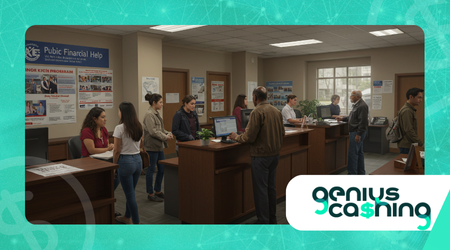When and Why to Say No to Public Financial Help

Public funding is often seen as a lifeline—something every entrepreneur should pursue when offered. But that assumption can lead to costly missteps.
Anúncios
Not every financial aid program aligns with your mission, your model, or your growth timeline. Sometimes, the smartest move is the one that feels counterintuitive: saying no.
Understanding when to say no to public financial help isn’t about arrogance or missed opportunities. It’s about alignment. Founders who chase every incentive risk losing control, diluting focus, or getting entangled in bureaucracy that slows them down when speed matters most.
Strategic decision-making means knowing which funds serve your future—and which could cost you more than they’re worth.
The Hidden Cost of Free Money
Most government grants or subsidies come with strings attached—compliance, reporting, restricted use of funds, and even mandatory partnerships or hiring quotas. What looks like free money on paper can quickly become a drain on time, flexibility, and core vision.
Anúncios
For lean teams or founders in fast-moving industries, this burden can be paralyzing. You trade agility for approval cycles, and clarity for compliance. If every dollar takes weeks of paperwork or pivots your strategy to fit an external mold, is it really worth it?
When Control Matters More Than Capital
If you’re in a creative, tech-driven, or fast-growth environment, preserving control may be more valuable than low-interest loans or matching grants.
Government programs can demand co-investors, stakeholder oversight, or business model disclosures that slow down momentum or introduce outside pressure.
Control allows founders to take bets, shift direction, and learn fast. Public funding, while generous, often operates on long timelines and rigid expectations. If your vision depends on experimentation or fast iterations, external obligations may do more harm than good.
Read also: Stop Blaming the Economy: Internal Deficit Triggers You Control
Early-Stage Startups and Unpredictable Trade-Offs
Early-stage companies often believe they need capital at any cost. But not all money is right for every phase. Public programs may expect stability, clear projections, or social impact metrics that aren’t yet realistic.
Startups still validating product-market fit or pivoting their business model could find themselves locked into a trajectory defined by a funding application—not their customers. And that kind of misalignment can sabotage the very growth the funds were supposed to support.
The Reputation Risk of Overdependence
Public records show who accepts what funding. If your brand builds itself around independence, speed, or disruption, being tied too visibly to state support can send the wrong message.
Worse, some companies develop a dependency on public grants instead of solving for profitability. It can create a culture of survival rather than scale. Instead of investing in revenue systems, they chase the next subsidy—until the money stops.
Say No to Public Financial Help When It Delays Your Vision
Sometimes, aid pushes founders toward paths that feel safe but aren’t strategic. For instance, hiring because a grant subsidizes salaries—even if the hires aren’t needed. Or opening a new location to qualify for tax incentives before demand exists.
If financial help slows your responsiveness to market feedback or forces growth before you’re ready, it’s a distraction, not support.
Say No When It Jeopardizes Equity and Autonomy
Some programs, especially those involving public-private partnerships or economic development funds, require equity positions or advisory board seats. This can create hidden influence over your company’s direction—and potentially dilute your ability to lead decisively.
For founders building something deeply personal or innovative, outside influence—even when wrapped in financial support—can create long-term friction that’s hard to reverse.
Say No When It Complicates Future Funding
Investors look at your cap table, your past funding, and your growth decisions. If public financial help ties you to milestones that don’t align with market potential or makes your operations overly bureaucratic, it could be a red flag.
Sometimes the cleanest cap table, the fastest decisions, and the leanest process win. And that means declining funding that adds drag instead of lift.
Conclusion: Strategy Over Subsidy
Saying no to public financial help isn’t a rejection of support—it’s a commitment to direction. Every dollar you accept defines how you operate, what you prioritize, and how quickly you can move. If the funding doesn’t fuel your trajectory, it slows you down.
Don’t chase capital that pulls you away from clarity. Say no when it clouds your mission, delays your execution, or compromises your independence. The right money is never just about the terms—it’s about what it lets you do, and who it lets you become.
Questions About When to Say No to Public Financial Help
How do I know if public funding isn’t right for my startup?
If it requires you to slow down, change your product roadmap, or create processes that don’t align with your business stage, it may be a sign to walk away.
Is turning down public financial help a red flag to investors?
No—if done strategically, it can show clarity, discipline, and focus. Investors often prefer founders who protect their autonomy and avoid dependency.
Can I apply for public funds later if I say no now?
Yes, most programs allow future participation. Declining now doesn’t mean burning bridges. You can always reapply when the timing fits your goals.
What should I consider before accepting government funding?
Look at time requirements, compliance complexity, restrictions on spending, reporting needs, and long-term impact on agility and control.
Are there situations where public help is clearly a yes?
Yes—when it aligns with your timeline, growth model, and team capacity to manage it. Especially in industries where regulation, infrastructure, or social impact is central.
